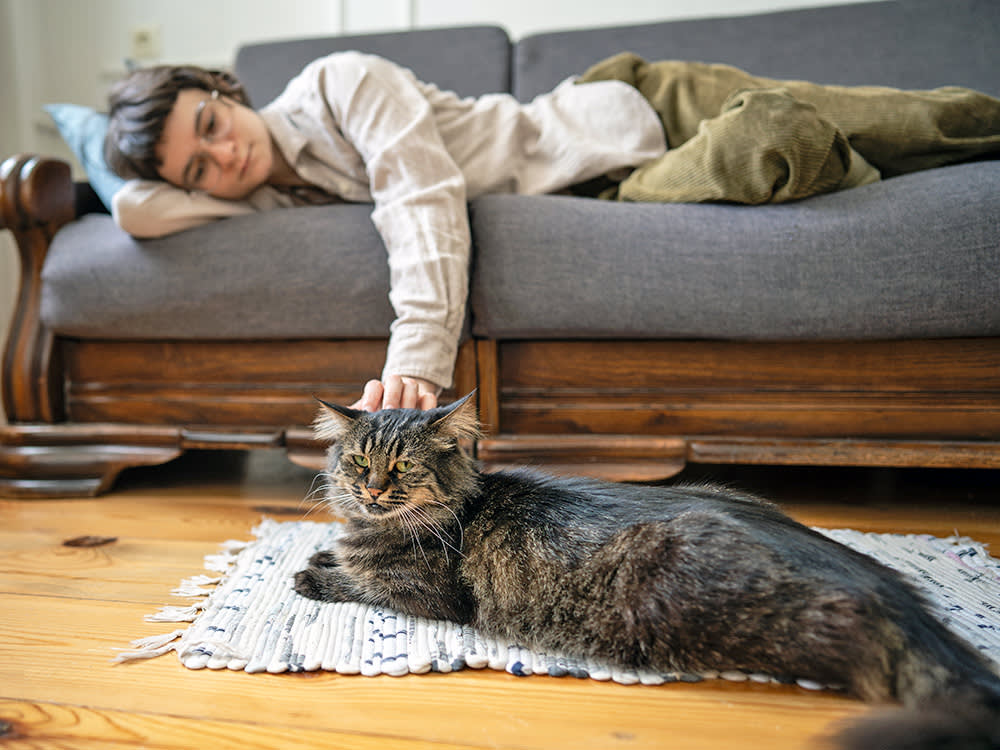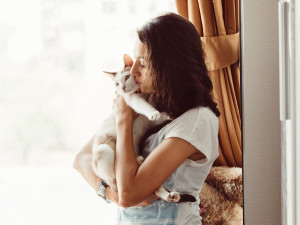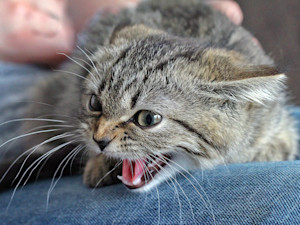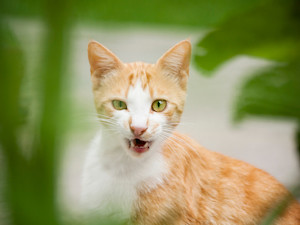Warning Signs Your Cat Is Crying for Help: What to Watch For
What is your kitty trying to tell you? We’ll help you decipher what they’re saying.
In This Article:
Understanding Your Cat’s Behavior Key Warning Signs Your Cat Is Crying for Help Behavior Changes To Be Aware Of Physical Signs to Be Aware Of Signs of Pain or Discomfort When to Seek Veterinary Help for Warning Signs
How many times have you wished your cat could just... talk to you? Caring for a cat is a lot like caring for a child. Babies cry, and you have to figure out why they’re crying and what you need to do to keep them healthy.
Cats are the same way. They have several different cries, but not all are signs of distress. Some cats cry when they’re hungry. Others cry when they want attention. It’s good to become familiar with your cat’s ordinary cries that aren't a result of an illness or injury, so you can recognize when a cry may be due to something more urgent.
Save on the litter with color-changing tech that helps you better care for your cat.
However, cats are very good at hiding distress and not crying at all. Instead, they show their discomfort in other ways, such as physical symptoms, behavioral changes, or changes in their daily habits. This guide will help you recognize early red flags, interpret your cat’s signals, and know when to seek veterinary attention before a minor issue becomes a significant health concern.
How much do you spend on your pet per year?
Understanding your cat’s behavior
The first sign that something is wrong with your cat is probably going to be a behavior change. That usually comes before obvious physical symptoms. Knowing what is normal for your kitty is essential to knowing when things just aren’t right.
If you watch your cat for a few days, you will probably discover that they follow a very predictable routine. Cats keep a fairly strict schedule for eating, grooming, sleeping, and playing. When those patterns change, something may be bothering your cat. It could be physical discomfort or behavioral issues that result from stress or environmental changes, such as adding a new pet to the household or moving to a new home.
If it’s a behavioral change, you can monitor it for a day or so. But if it persists, you may want to have your kitty seen by a vet. A behavioral problem can be hiding a physical ailment.
Key warning signs your cat is crying for help
Even if your cat doesn’t cry when in pain, there are ways to figure out that something is wrong. When cats are distressed, they tend to exhibit changes in behavior, physical appearance, or daily habits. These can fall into three main categories.
Behavioral changes: How they act around you and their surroundings
Physical changes: Visible differences in body condition or grooming
Signs of pain or discomfort: Indications your cat may be physically suffering
Discovering a problem early is critical for getting a proper diagnosis and treatment, which, if started early, can lead to a much better outcome.
Behavior changes to be aware of
Often, a behavior change is the first sign that something is bothering your cat. Behavior changes include the following.
Increased aggression
If your cat is usually well-tempered and calm, but suddenly starts hissing, biting, or swatting, something is wrong. It could be fear, pain, or another environmental or physical problem. If your cat is experiencing pain and you touch a sensitive area, they can associate you with pain and lash out.
Cats rarely become aggressive from a bad mood. A drastic personality shift can indicate underlying issues such as vision or hearing loss, dental pain, arthritis, or an environmental change that’s bothering them. Always rule out medical causes first.
Withdrawal or hiding
Cats are big on hiding when something is bothering them. They tend to go under beds, in closets, or to any secluded place. This is a significant red flag that something is bothering your kitty. If this persists for more than a short while, a trip to the veterinarian is in order.
Physical signs to be aware of
Physical symptoms are often easier to spot. The following are a few of the most common.
Changes in grooming habits
If your cat suddenly develops a matted coat or appears greasy and unkempt, it could be due to not grooming. And this is a cause for concern. If your cat isn’t grooming normally, it could be due to arthritis, obesity, pain, or any illness.
Conversely, although grooming is a normal feline behavior, overgrooming — especially to the point of hair loss or skin irritation — signals stress or medical problems. Sometimes it’s a psychological problem where your cat finds that grooming soothes their anxiety, but it could also be allergies, parasites, or skin infections. This calls for a vet visit.
Noticeable weight loss or gain
Weight change is a significant indicator of health problems.
Weight loss may signal hyperthyroidism, diabetes, kidney disease, cancer, or malabsorption.
Weight gain can occur from overfeeding, reduced activity, or hormonal imbalances.
Because cats are so small, even a slight weight change is notable and should be evaluated by your veterinarian.
Lumps or swelling
A vet should evaluate any lump, bump, or swelling under your cat’s skin. Although dogs commonly get lumps and bumps, especially as they age, cats do not. When they do, consult your vet. Some may be benign, while others could be more serious. Monitor your cat periodically for new growths. Early detection leads to a better prognosis.
Loss of appetite
Despite some cats being finicky eaters, a loss of appetite is a sign that your cat isn’t feeling well. There are two reasons to be concerned if your cat isn’t eating or is eating much less. First, it signals something is wrong medically. Secondly, cats can develop hepatic lipidosis (fatty liver disease) just from the act of not eating.
Fatty liver disease is serious and can even be fatal. Illnesses ranging from dental pain and infections to gastrointestinal or metabolic disorders can suppress their appetites. If your cat refuses food for more than 24 hours, call your vet promptly.
How your cat drinks can also give you clues about their health. Not drinking as much is usually associated with a loss of appetite. However, drinking more is the usual tip-off for such diseases as hyperthyroidism, diabetes, and kidney disease.
Vomiting or diarrhea
It’s not unusual for a cat to vomit occasionally. All that self-grooming leads to irritation from hair or even large hairballs. Diarrhea, on the other hand, is not common. Either condition is a sign to take notice. Many factors, including internal organ disease, dietary intolerance, infections, toxins, and parasites, can cause vomiting and diarrhea.
Multiple bouts of vomiting or diarrhea can cause dehydration, which leads to your pet feeling worse. Chronic GI symptoms suggest your cat needs to see a vet who can determine the underlying cause and suggest a treatment plan.
Excessive meowing
If you have a Siamese cat, you may be quite used to excessive meowing. Even then, you’ll want to pay attention to any change in pitch, intensity, or frequency. As for other cats, a sudden increase in meowing is worth noting. Meowing isn’t the number one sign of pain (hiding and not eating are), but it can indicate such things as deafness, hyperthyroidism, anxiety, or cognitive dysfunction. It’s not something to ignore.
Signs of pain or discomfort
Cats hide pain instinctively, making it hard for us to know when they’re uncomfortable. However, they do often reveal their pain through subtle physical cues and behavior changes.
Limping or difficulty moving
Limping is one of the most obvious signs, and it’s hard to miss. A limp, reluctance to jump, or stiffness when standing up may indicate joint problems, injury, or arthritis. Other signs include avoiding stairs, hesitating before jumping onto furniture, or even missing the furniture. Even a slight change in mobility is worth investigating, because, as with everything else, early detection leads to better outcomes.
Sensitivity to touch
If your cat reacts negatively when touched in a specific area, this could be a sign of pain or internal discomfort. Cats may also resist being picked up or brushed.
Common pain points include soft tissue injuries, the mouth (due to dental disease), the spine, the abdomen, or the bladder if there’s a blockage or infection.
When to seek veterinary help for warning signs
Acting quickly in an emergency can make a big difference. Contact your veterinarian right away if you notice, in your cat:
Continued vomiting or diarrhea lasting more than 24 hours
Not eating or drinking
Labored or rapid breathing
Sudden collapse, lethargy, or unresponsiveness
Blood in urine, stool, or vomit
Visible wounds or swellings
Straining to urinate (especially in male cats)
Less urgent symptoms, such as gradual weight loss, a dull coat, or behavioral changes, should also be evaluated by your veterinarian if they persist for more than a few days.
Bottom line
Cats meow, some more than others, and in several different ways — but unfortunately, meowing is not the way they usually show pain. They try to hide their pain by crawling under the bed, the furniture, or in a closet. That leaves pet parents clueless unless they know their cat’s routine and behavior well. If you know what’s normal, you can detect when something is abnormal.
They may not cry with their voices, but when something is bothering them, cats’ behavior, appetites, grooming behaviors, and mobility will let you know they are crying for help. If something seems off, but you’re not sure, see your veterinarian. If a condition is detected early, there’s a much better chance of treatment and a good outcome.
References
Merola, Isabella, and Daniel S. Mills. “Behavioural Signs of Pain in Cats: An Expert Consensus.” PLOS ONE, vol. 11, no. 2, 24 Feb. 2016, p. e0150040, www.ncbi.nlm.nih.gov/pmc/articles/PMC4765852opens in new tab.
Merola, Isabella, and Daniel S Mills. “Systematic Review of the Behavioural Assessment of Pain in Cats.” Journal of Feline Medicine and Surgery, vol. 18, no. 2, 13 May 2015, pp. 60–76, doi.org/10.1177/1098612x15578725opens in new tab.
Monteiro, Beatriz P, and Paulo V Steagall. “Chronic Pain in Cats: Recent Advances in Clinical Assessment.” Journal of Feline Medicine and Surgery, vol. 21, no. 7, 25 June 2019, pp. 601–614. journals.sagepub.com/doi/10.1177/1098612X19856179opens in new tab.










